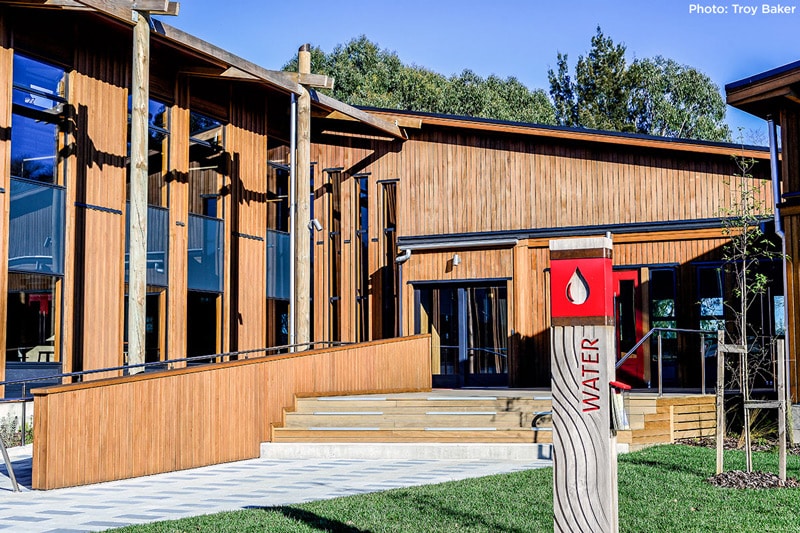
How the Living Building Challenge is a powerful tool for driving regenerative design
The Living Building Challenge® (LBC), developed and managed by the International Living Future Institute (ILFI), is one of the most stringent green building certification programs in the world. It aims to promote sustainability through a holistic approach, addressing seven key performance areas known as Petals: Place, Water, Energy, Health & Happiness, Materials, Equity, and Beauty.
Each Petal comprises several Imperatives, which are specific performance goals that buildings must meet to achieve certification.
The Value of the “Three-Quarters Baked” Approach
The LBC is often described as “three-quarters baked”. This phrase highlights the program’s unique blend of defined standards and flexible guidelines, as well as its continual evolution as a “living” standard, regularly updated based on feedback from completed projects, technological advancements, and shifts in environmental policy.
This is what makes Living Buildings so transformational.
The concept of “three-quarters” baked was developed by Jason McLennan, who is considered one of the world’s most influential figures in the field of architecture and the green building movement.
Unlike more prescriptive building certification systems typically used in Australia and New Zealand, the LBC encourages innovation and adaptability, allowing projects across the globe and across all building typologies to meet the Imperative requirements in ways that are most relevant to their context, such as aligning with local building codes, planning rules and construction supply chains.
This approach stems from the recognition that every project operates within a unique set of environmental, social, contextual and economic conditions.
The “three-quarters baked” nature of the LBC provides not only a solid framework and a clear set of performance outcomes that must be proven in occupation, but leaves room for creative problem-solving to develop a response that is best suited to the project specifics.
For instance, while the Materials Petal mandates avoiding harmful substances and sourcing responsibly, it does not dictate specific products, allowing teams to find appropriate local, sustainable materials that fit their project.
The Request for Ruling Process
To some developers and building designers who may be more familiar with other green building rating tools, the lack of prescriptive requirements within some parts of the LBC may seem a risk.
This is where the Request for Ruling (RfR) process comes in.
The RfR process is a critical component of the LBC, designed to provide clarity and facilitate pre-approval on specific compliance strategies or interpretations of the Imperatives before design or construction has been completed.
This proactive engagement reduces risk and ensures that projects are on the right track and can address potential issues early in the development process.
Project teams for registered LBC projects are also provided with support from the ILFI, including a dedicated project coach, three project status calls, and access to request clarifications and exceptions to certification requirements.
The RfR process involves submitting a detailed inquiry to the ILFI, outlining the project’s proposed approach and how it aligns with the LBC’s goals. The ILFI then reviews the request and provides a ruling, which can either approve the proposed strategy, suggest modifications, or offer alternative solutions.
The RfR process benefits the wider industry too, because documented rulings contribute to a shared knowledge base, allowing the broader LBC community to learn from each project’s experiences.
Real World Examples
One example of how the LBC’s processes can provide flexibility to allow for local project requirements can be seen in the Te Kura Whare project in New Zealand.
At that time, the nominated product air quality testing standards in LBC Version 3 were not used for many products available in the Oceania region.
Through the Dialogue process, the project team were able to seek approval from the ILFI to use products tested and certified to equivalent standards that were more regularly available in the local market. Following the approval of this approach, an Exception was created which allowed all future Oceania-based projects to use the same approach.
A second interesting example of the RfR process in action is the Desert Rain House in Oregon, USA.
During its construction, the project team faced challenges in sourcing materials that could meet the stringent LBC Red List requirements, which prohibit the use of harmful chemicals.
By engaging with the ILFI through the RfR process, they were able to get approvals for using certain reclaimed materials and innovative building techniques that both met the intent of the LBC and aligned with the project’s sustainability goals.
The RfR process is essential for empowering project teams to navigate compliance with clarity and confidence.
It provides a structured yet flexible pathway for addressing complex sustainability challenges, ensuring that projects can achieve their environmental and social goals without unnecessary delays or uncertainties.
Innovative Approach to Sustainability
The LBC stands out for its rigorous standards and holistic innovative approach to sustainability.
By being “three-quarters baked,” it balances firm requirements with the flexibility needed to adapt to diverse project contexts. The RfR process further enhances this adaptability, enabling proactive engagement with the ILFI to resolve compliance questions and de-risk projects.
Together, these features make the LBC a powerful tool for driving meaningful and context-sensitive regenerative design and construction in the built environment.
Want to learn more?
Learn more about the Living Building Challenge and the Request for Ruling process.
This article was written with the assistance of Open AI ChatGPT-4.
Contributor



